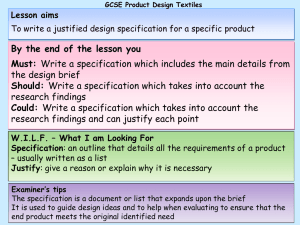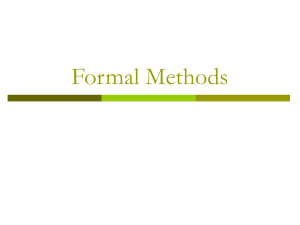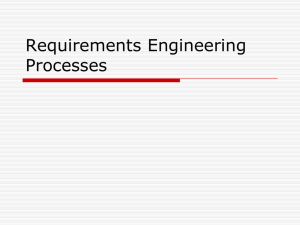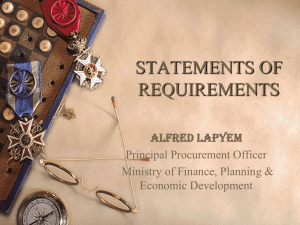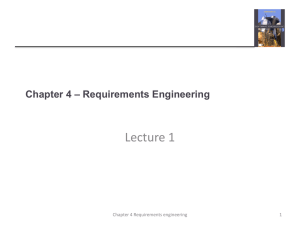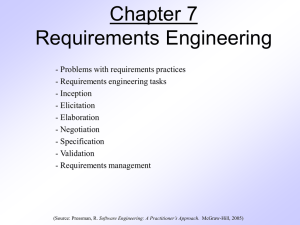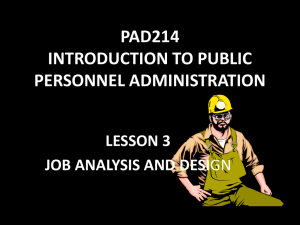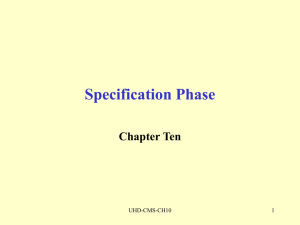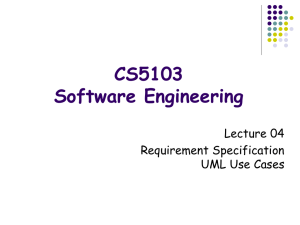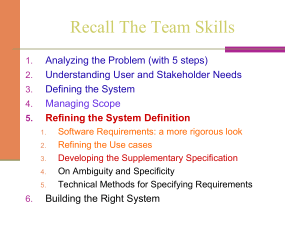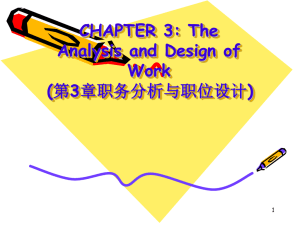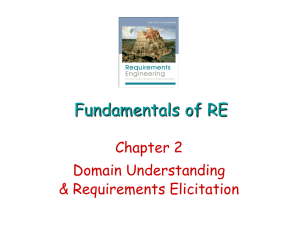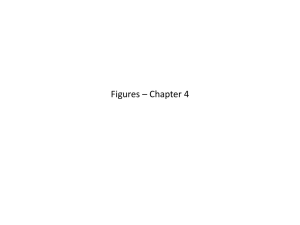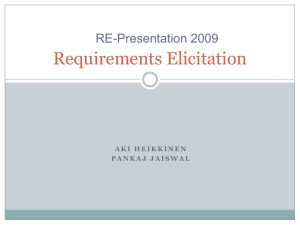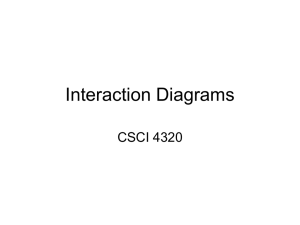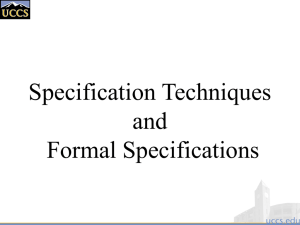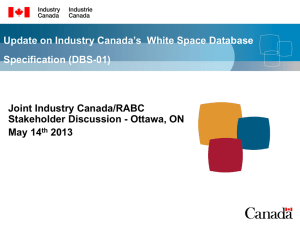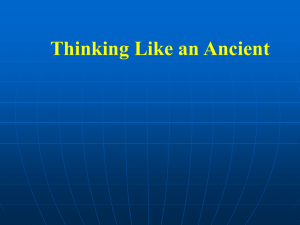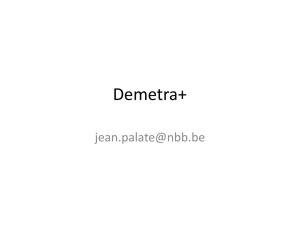Requirements Analysis and Specification
advertisement
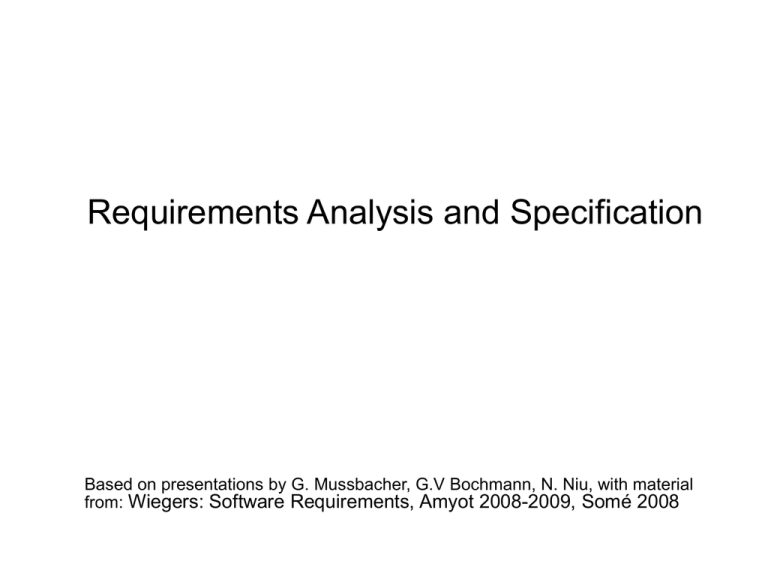
Requirements Analysis and Specification Based on presentations by G. Mussbacher, G.V Bochmann, N. Niu, with material from: Wiegers: Software Requirements, Amyot 2008-2009, Somé 2008 RE process model (suggested by Bray) Again, this diagram shows • RE activities (elicitation, analysis, specification, HMI design) • subsequent design activity (internal design) • RE documents (requirements, specification, HMI specification) Important point: Distinction between • Problem domain (described by requ. doc.) • System (to be built) (described by spec. doc.) Note: one has to distinguish between current (problematic) version of the problem domain, and the projected future version which includes the system to be built. What is Requirements Analysis The process of studying and analyzing the customer and the user needs to arrive at a definition of the problem domain and system requirements Objectives – Discover the boundaries of the new system (or software) and how it must interact with its environment within the new problem domain – Detect and resolve conflicts between (user) requirements – Negotiate priorities of stakeholders – Prioritize and triage requirements – Elaborate system requirements, defined in the requirement specification document, such that managers can give realistic project estimates and developers can design, implement, and test – Classify requirements information into various categories and allocate requirements to sub-systems – Evaluate requirements for desirable qualities Questions • We have seen how to specify requirements in terms of structure, standards, and writing rules, but: – How to identify the real problems to solve in the elicitation results? – How to detect conflicting aspects? – How to negotiate to resolve conflicts? – How to decide what is important and a priority? – How to ensure that nothing is forgotten? – How to validate that the findings of the analysis are good? – How to use models in this context? How to Find the Real Problems? • Ask: Why? – Root cause analysis – Determine (recursively) the factors that contribute to the problem(s) found by stakeholders • The causes do not all have the same impact nor the same weight – Some may perhaps not deserve to be corrected, at least for the moment • Goal-oriented modeling can help understand these causes and their relationships • This analysis identifies problems that need to be solved What is Requirements Specification? • The invention and definition of the behavior of a new system (solution domain) such that it will produce the required effects in the problem domain • Start from a knowledge of the problem domain and the required effects determined by elicitation and analysis • Generally involves modeling • Results in the specification document – Precise expression of requirements, may include models problem domain Domain properties Requirements interface solution system Specification description of Solution System needed to satisfy Problem Domain Hardware Software Requirements Analysis • Problem analysis – Development of product vision and project scope • Analysis and elicitation feed each other Elicitation Elicitation Notes Questions and points to consider Analysis • Requirements Specification Analysis goes hand-in-hand with modeling Requirements Modeling • Elicitation/analysis and modeling are intermixed Source: http://www.telelogic.com/download/paper/SystemsEngineeringSandwich.pdf Requirements Modeling This is an essential task in specifying requirements • Map elements obtained by elicitation to a more precise form • Help better understand the problem • Help find what is missing or needs further discussion • Different modeling languages – Informal: natural language – Goal-oriented modeling (GRL) – Functional modeling: UML (Unified Modeling Notation) SDL (Specification and Description Language) Logic, e.g. Z, VDM (Vienna Development Method) UCM (Use Case Maps) ... Requirements Verification and Validation • Need to be performed at every stage during the (requirements) process – Elicitation • Checking back with the elicitation sources • “So, are you saying that . . . . . ?” – Analysis • Checking that the domain description and requirements are correct – Specification • Checking that the defined system requirement will meet the user requirements under the assumptions of the domain/environment • Checking conformity to well-formedness rules, standards… Structuring requirements Requirements Classification In order to better understand and manage the large number of requirements, it is important to organize them in logical clusters • It is possible to classify the requirements by the following categories (or any other clustering that appears to be convenient) – – – – – Features Use cases Mode of operation User class Responsible subsystem • This makes it easier to understand the intended capabilities of the product • And more effective to manage and prioritize large groups rather than single requirements Requirements Classification – Features • A Feature is – a set of logically related (functional) requirements that provides a capability to the user and enables the satisfaction of a business objective • The description of a feature should include1 – – – – Name of feature (e.g. Spell check) Description and Priority Stimulus/response sequences List of associated functional requirements [1] Source: K.E. Wiegers Requirements Classification – Feature Example (1) • 3.1 Order Meals – 3.1.1 Description and Priority • A cafeteria Patron whose identity has been verified may order meals either to be delivered to a specified company location or to be picked up in the cafeteria. A Patron may cancel or change a meal order if it has not yet been prepared. • Priority = High. – 3.1.2 Stimulus/Response Sequences • Stimulus: Patron requests to place an order for one or more meals. • Response: System queries Patron for details of meal(s), payment, and delivery instructions. • Stimulus: Patron requests to change a meal order. • Response: If status is “Accepted,” system allows user to edit a previous meal order. Source: K.E. Wiegers Requirements Classification – Feature Example (2) • Stimulus: Patron requests to cancel a meal order. • Response: If status is “Accepted, ”system cancels a meal order. – 3.1.3 Functional Requirements • 3.1.3.1. The system shall let a Patron who is logged into the Cafeteria Ordering System place an order for one or more meals. • 3.1.3.2. The system shall confirm that the Patron is registered for payroll deduction to place an order. • ...... Source: K.E. Wiegers External design Requirements Specification = External Design • Requirements Specification is «The invention and definition of the behavior of a new system (solution domain) such that it will produce the required effects in the problem domain » • During Requirements Analysis, one finds the existing properties of the problem domain, as well as the requirements that should be satisfied in the domain-to-be. We assume that the domain-to-be will include a new system-to-be-built and other aspects of the domain may also be changed. • The determination of this domain-to-be, including the system-to-be) is a typical design process. It is called external design because the system-to-be is considered during this process as a black-box and the external environment of it is designed (in a white-box manner) – the domain-to-be. The World and the Machine1 (or the problem domain and the system) Domain properties (D) these are assumptions about the environment of the system-to-be Requirements (R) Specification (S) problem domain interface solution system Hardware (C) Software (P) • Validation question (do we build the • Verification question (do we right system?) : if the domain-to-be build the system right?) : if the (excluding the system-to-be) has hardware has the properties H, the properties D, and the systemand the software has the to-be has the properties S, then properties P, then the system the requirements R will be requirements S will be satisfied. satisfied. D and S R C and P S • Conclusion: [1] M. Jackson, 1995 D and C and P R Example • Requirement – (R) Reverse thrust shall only be enabled when the aircraft is moving on runway. • Domain Properties – (D1) Deploying reverse thrust in mid-flight has catastrophic effects. – (D2) Wheel pulses are on if and only if wheels are turning. – (D3) Wheels are turning if and only if the plane is moving on the runway. • System specification – (S) The system shall allow reverse thrust to be enabled if and only if wheel pulses are on. • Does D1 and D2 and D3 and S R? – Are the domain assumptions (D) right? Are the requirement (R) or specification (S) what is really needed? based on P. Heymans, 2005 Requirement specifications including assumptions • Often the requirements for a system-to-be include assumptions about the environment of the system. • The system specification S, then, has the form: S=A G where A are the assumptions about the environment and G are the guarantees that the system will provide as long as A hold. • If these assumptions (A) are implied by the known properties of the domain (D), that is D A, and we can check that the domain properties (D) and the system guarantees (G) imply the requirements (R), that is D and G R, then the “validation condition” D and S R is satisfied. Specification with assumptions and guarantees (example) Example: A power utility provides electricity to a client. The problem is that the monthly invoice is not related to the electricity consumption, because there is no information about this consumption. • Idea of a solution: introduce an electricity counter. • Specification of the electricity counter – Inputs and outputs • input power from utility (voltage, current) – voltage supplied by utility • output power to client (voltage, current) – current used by client • Reset button (input) • consumption (output - watt-hours of electricity consumption) Example (suite) – Assumptions • Input voltage < 500 Volts (determined by utility) • Output current < 20 Amps (determined by client) – Guarantees • Output voltage = input voltage • Input current = output current • Consumption output shall indicate the consumption since the last reset operation, that is, the integral of (output voltage x output current) over the time period from the occurrence of the last reset operation to the current time instant. • Software example • Specification of a method providing the interface “List search(Criteria c. Assumption: c is a data structure satisfying the Criteria class properties. Guarantee: the returned result is a list satisfying the List class properties and includes all items from the database that satisfy c. Formal Verification and Validation • Evaluating the satisfaction of “D and S R” is difficult with natural language – Descriptions are verbose, informal, ambiguous, incomplete... – This represents a risk for the development and organization • Verification of this “validation question” is more effective with formal methods (see below) – Based on mathematically formal syntax and semantics – Proving can be tool-supported • We can also reduce this risk by using semi-formal modeling The Use of Models Models • According to B. Selic, a model is a reduced representation (simplified, abstract) of (one aspect of) a system used to: – Help understand complex problems and / or solutions – Communicate information about the problem / solution – Direct implementation • Qualities of a good model – – – – – Abstract Understandable Accurate Predictive Inexpensive Modeling Notations Natural language (English) + No special training required - Ambiguous, verbose, vague, obscure ... - No automation Ad hoc notation (bubbles and arrows) + No special training required - No syntax formally defined - meaning not clear, ambiguous - No automation Semi-formal notation (URN, UML...) + Syntax (graphics) well defined + Partial common understanding, reasonably easy to learn + Partial automation - Meaning only defined informally - Still a risk of ambiguities Formal notation (Logic, SDL, Petri nets, FSM ...) + Syntax & semantics defined + Great automation (analysis and transformations) - More difficult to learn & understand Modeling notations (2) • Informal language is better understood by all stakeholders – – – – Good for user requirements, contract But, language lacks precision Possibility for ambiguities Lack of tool support • Formal languages are more precise – Fewer possibilities for ambiguities – Offer tool support (e.g. automated verification and transformation) – Intended for developers Source (for decision table): Easterbrook and Callahan, 1997 Modeling Structure Concepts of Entities and their Relationships. Use one of the following notations: – ERD (Entity Relationship Diagram – the traditional version) – UML class diagrams – Relational tables • Can be used for the following – Model of the problem domain (called “domain model”) • The two versions: existing and to-be – Model of input and output data structures of system-to-be – Model of the stored data (database) • not necessarily an image of the domain data • Additional data is introduced (e.g. user preferences) – Architectural design of the system-to-be Modeling inputs and outputs • Nature of inputs and outputs: – IO related to problem (problem data) – Additional data related to solution (solution data) • E.g., prompts, user options, error messages… • Collected in Data Dictionary using – – – – – – Plain text (natural language) EBNF Code-like notations Logic (e.g., VDM) Structure charts … • Graphical output (screens, forms) – Iconic (representational) drawings, prototype screens or forms, printouts produced by operational prototype Modeling Dynamic Behavior • Behavior modeling techniques – – – – Text (plain, function statements, use cases) Decision tables Activity Diagrams / Use Case Maps Finite state machines • Simple state machines (FSM) : use state diagrams or transition table notation • Extended state machines (e.g. UML State Machines – including SDL) • Harel’s State Charts (concepts included in UML notation) • Petri nets (allows for flexible concurrency, e.g. for data flow, similar to Activitity Diagrams) – Logic (e.g. Z, VDM) for describing input-output assertions and possibly relationship to internal object state that is updated by operations) • It is important to chose what best suits the problem Model Analysis • By construction – We learn by questioning and describing the system • By inspection – Execute/analyze the model in our minds – Reliable? • By formal analysis – Requires formal semantics (mathematical) and tools – Reliable (in theory), but expensive (for certain modeling approaches) • By testing – – – – Execution, simulation, animation, test... Requires well-defined semantics and execution/simulation tools More reliable than inspection for certain aspects Possible to interact directly with the model (prototype) Typical Modeling Approaches • Many approaches involve modeling to get a global picture of the requirements – – – – – Structured Analysis (1970) Object-Oriented Analysis (1990) Problem Frames (1995) State Machine-Based Analysis Conflict Analysis • E.g. with mis-use cases or with GRL/UCM models and strategies/scenarios • It is important to distinguish between – Notation used for defining the model – Process defining a sequence of activities leading to a desired model • Note: Analysis can be on individual requirements as well – Remember tips and tricks on how to write better requirements

